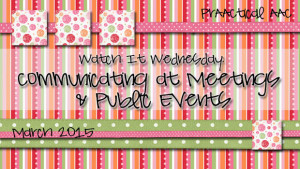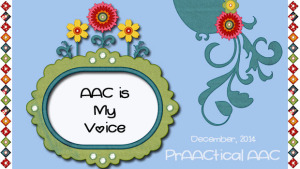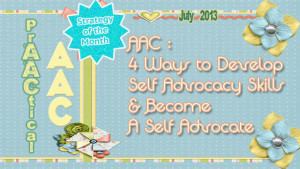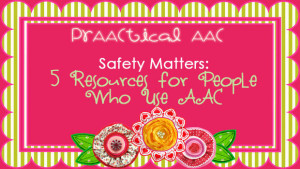March 11, 2015
by Carole Zangari -

When people who use AAC participate in team or committee meetings, they are generally welcomed by others in attendance. That’s a great start, but for the experience to be successful, we have to go beyond good intentions and use solid inclusive practices so that the group benefits from the perspective or information shared by the person using AAC. Helping people with AAC needs be full participants in team and other group meetings is an area where SLPs can make a positive impact. In this video by Communication Disabilities Access Across Canada, we learn how we can go beyond supporting the individual who uses AAC (which may be necessary but not sufficient) and help the team develop good practices for inclusive practices.
Filed under: Video of the Week
Tagged With: Communication Disabilities Access Canada, inclusion, meetings, participation, self-advocacy
December 15, 2014
by Carole Zangari -

Filed under: PrAACtical Thinking
Tagged With: advocacy, self-advocacy, self-determination
July 20, 2013
by Robin Parker -

Self Advocacy comes in many shapes and forms for all learners. We all need to have a level of self advocacy skills to have a positive self-esteem, to continue a path of life long learning, and to defend and protect ourselves in situations that potentially can be harmful. The teaching of self advocacy begins with learning to request and protest but goes way beyond that for ALL learners. For those with AAC needs, specific strategies and direct instruction are often necessary to make self advocacy a comprehensive and robust skill. Self advocacy skills are a priority for older learners so for our Strategy of the Month, we will discuss some ways to help develop self advocacy skills beyond the requesting and protesting levels. We hope to build strong self advocacy skills for ALL learners. Rating Scales– Teach the use of rating scales to help AAC learners give their opinions on... [Read More...]
Filed under: Strategy of the Month
Tagged With: self-advocacy
June 21, 2013
by Carole Zangari -

Though she was not the first of my clients with cerebral palsy who made me think long and hard about safety, Marla was the one who kept me up at night. It was the seventies, and I was a PCA when institutionalization was on the way out and community living was gaining ground. Marla lived on her own in an apartment and, for awhile when I was a college student, I visited her in the morning to get her up and at night to put her to bed. During the day, she could get around reasonably well and call for help if she needed it. But at night, after she was settled in bed, she was pretty much stuck there until someone returned in the morning. She didn’t have the physical skills to use a phone while lying down, and, if there was AT that would have helped, I... [Read More...]
Filed under: PrAACtical Thinking
Tagged With: communication boards, resources, safety, self-advocacy
September 17, 2012
by Carole Zangari -

There are things no one likes to talk about. Serious things. Sensitive things. Nonetheless, everyone deserves the tools to be able to talk about whatever they want to share. The How It Is Project, by the UK-based Triangle organization, offers a set of free pictures developed so that everyone has access to images they can use to talk about their feelings, their rights, personal safety, personal care, and sexuality. We love how they developed the vocabulary list and symbols on the site with the help of children and youth with and without disabilities. You can download the document with images here.
Filed under: PrAACtical Thinking
Tagged With: advocacy, self-advocacy, symbol, vocabulary




